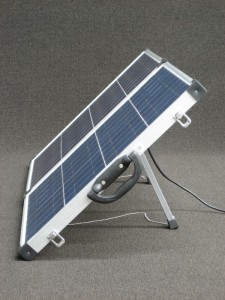As good as solar power seems to be, it is not the cure all that will restore used up energy. Some people who want to reinstate power in their motors or vehicles like RVs, house or other electrical devices, want it done in a very short time. To illustrate the amount of time needed to charge a battery by using solar panels, take for example a discharged 100 amp hour battery and juice it up using a 30-watt solar panel during summertime, perfect conditions for sunlight. It will take a full week or so until it becomes fully charged. As you can see, it will take almost 100-watts of solar energy before the battery can be recharged at 100-amp. It is also important to remember that it takes full, 100% sunlight in order for the panel to generate 100% energy. Plenty of factors like overcast skies, or improper mounting of the panels will affect the output of the panels.
Solar panels are usually suited for 12 VDC appliances or batteries; however, this doesn’t mean that there aren’t smaller 24 volt panels available. When there is a need for a smaller 24 volt panel, stringing together a series of panels is possible.
Using a controller for the voltage is necessary if you will be using a solar panel that is capable of accommodating more than 5 watts. Having a controller can provide plenty of advantages since it will help to regulate overcharging. It also assists in improving the charge quality as well as prevents battery discharge if there is low or no light situations. To sum up, the solar panel charge controllers act like a switch, turning the inflow or outflow of the current or voltage. Controllers allow current to pass when there is a need for it and blocks it off if there isn’t or if the battery is already full. It is important to note when picking out a controller that they will be rated in amps while photovoltaic panels are measured in watts. For instance, the morning SS-6, since it is a 6 amp controller, it can work with all other types of panel save ones that are up to 70 watts.
Solar panels are rated in watts, thus, a rating of 15-watts will generate about 1 amp per hour when placed in full sunlight. For example, if you notice the SP-5 panel can create one third of an amp every single hour. This energy will be directed to storage in a battery until it is used later on. It also functions as a filter that will prevent damage to any susceptible devices that you will use.
